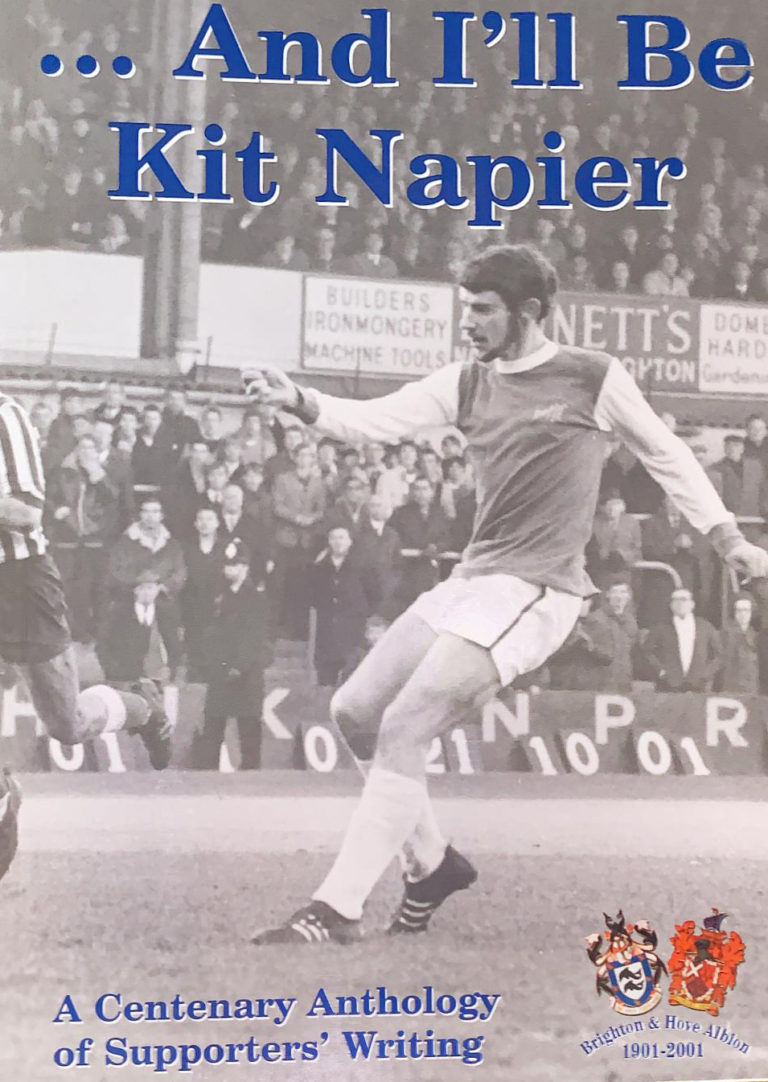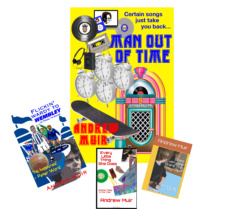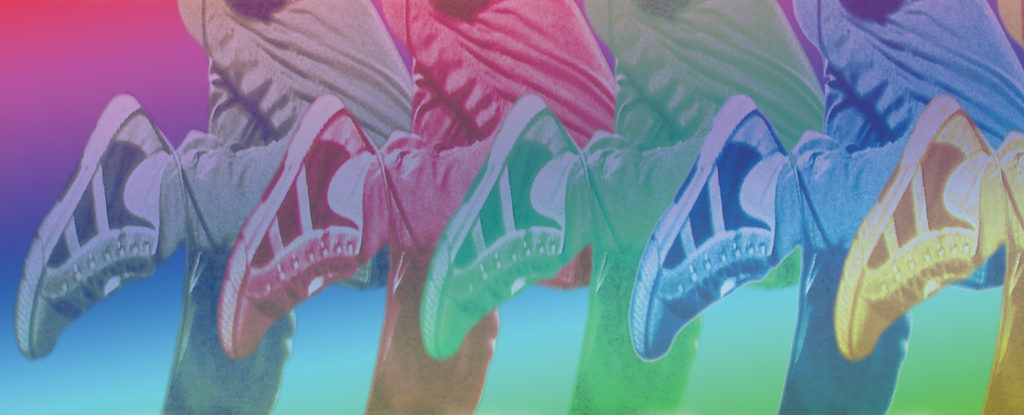
Latest Press Coverage - July 2023
An article on “Man Out Of Time” from Sussex World – July 2023
Latest Review

Thanks to the Book Reviewer of the Brighton Chronicle (December 2021 edition) for this review of Flickin’ Wardy to Wembley
Merry Christmas
Thanks to everyone who has purchased, borrowed or stolen my books this year.
Have a great Christmas and a Happy 2022

I am delighted to say that my interview with Luke Nicoli from Brighton and Hove Albion will feature in the Club programme for the home match with Leeds United on Saturday 27th November.
In the meantime, I enjoyed this review from ‘Comrade Sam’ on North Stand Chat recently;
Currently reading ‘Flicking Ward to Wembley.’ I think it was written for Brighton fans of my exact age. Man it’s a roller coaster. Whilst the last book I read was Howard Zinn’s ‘A People’s History of the United States’. Even the plight of the native Americans, the civil war, civil rights and the Vietnam war could not prepare me for the swings in historic fortunes. Without giving any spoilers, by page 3 Peter Ward has returned to the Albion and the Jam have split up!
From Kit to Wardy (in 20 slow years)
The seed from which my novel grew
It was in 2001, back in the days when Brighton and Hove Albion were still playing their home games as the local athletics stadium at Withdean (AKA The ‘Theatre of Trees), that the seed was sown for my latest novel, Flickin’ Wardy to Wembley.
It was the club’s centenary season and I read that celebrity fan John Baine (AKA Punk Poet ‘Attila the Stockbroker’) had the idea of putting together an anthology of fan’s writings to celebrate the occasion, invisting submission from all fans with regard to their Albion memories from the past 100 years.
Being a lifelong Albion fan and having only recently finished my second novel, Every Little Thing She Does, I thought ‘I fancy a bit of that’ and so I started working on a piece for the book.
I recall that the piece had to be limited to a certain number of words, which was a discipline I was used to, having written numerous short stories at that time and I set about writing something about my early memories of being a fan.
The result was a short essay which I entitled ‘And I’ll be Kit Napier’, recalling playground kick-abouts at my primary school in Coombe Road, Brighton.
My father took me to my first Brighton match on Boxing Day 1968 (we trounced Bournemouth 4-1 in the old Third Division). As a result, I was hooked and thereafter, stopped being Georgie Best in our break-time matches and opted instead to play as Kit Napier, then the star striker at The Goldstone Ground.
I tried to summarise my evolution as a die-hard Albion fan through the following years, from the third division days to the seasons of success and promotion to the first division (i.e. the heady days of a certain Peter Ward), right through to the club’s greatest day, the FA Cup Final in 1983, by which time I was celebrating my 21st birthday. In effect I was trying to describe 15 years in no more than 1500 words.
Having painstakingly written, re-written, chopped and edited the piece down to the requisite number of words, I sent my little effort off to ‘Atilla’ and waited…and waited.
Just as I was beginning to think my efforts had been in vain, I received word back to say that he liked the piece very much and would definitely be including it in the anthology. He even invited me to submit other pieces for consideration. (I duly submitted a second piece called ‘Love Me, Love Dean Saunders,’ a story about going on my very first date with my football hating, later-to-be-wife and boring her silly with my rants about The Albion selling off my favourite player at the time, for what I considered an insultingly knockdown price of £60,0000 – and although John was complementary about my second submission, it didn’t make the cut.)
However, I wasn’t too disappointed, especially when I saw the first press coverage for the book and realised that John / Attila had liked my first effort so much, he’d actually named the whole anthology ‘And I’ll be Kit Napier’ in honour of my submission!
During one of our subsequent email exchanges, John described my contribution as ‘one of the best pieces of football writing I’ve ever read.’ To say I was ‘chuffed’ would be an under-statement. Naturally, I bought a few copies of the book when it came out! My euphoria did take a slight knock one afternoon at the Withdean however, when John, who was then in charge of the PA system at the ground, announced details of the book, raving again about the title-piece before telling the amassed Withdean crowd that it had been written by….someone else completely.
Somewhat deflated that my moment of glory had been so cruelly snatched away fro mme, I emailed John the next day. He graciously apologized saying that he had actually thought he might have cocked-up at the time. Well, we had a ‘digital laugh’ about the situation and frankly, I thought ‘Ah well, at least me and my friends and family were in no doubt who’d actually written it- – especially, after I foisted copies on all and sundry!
That’s when I had an idea – maybe I could put together my own little anthology, starting with my two pieces and then building on them with other similar stories of my experiences of growing up supporting my beloved Seagulls. However, when I started setting out my thoughts, I realised that the majority of the chapters revolved around one player in particular – the remarkable Mr Ward and his incredible goalscoring antics of the late seventies and early eighties. So , I decided why not dedciate the whole thing to my recollections of Peter?
It took me another ten years and many false starts but I finally finished the book in 2021, by which time it had morphed from being a factual account of my memories of Wardy, into a work of fiction about a boy obsessed with Peter, Subbuteo and teenage angst.
So, the completed book really bears little resemblance to my original idea – but I still owe a debt of gratitude to Mr Baine and to ‘And I’ll be Kit Napier’ for sowing that seed.
Read ‘And I’ll be Kit Napier” below
And I'll be Kit Napier
On the 21st May 1983, Brighton and Hove Albion played Manchester United in The F.A.Cup Final at Wembley. Brighton won.
Not the way you remember it?
Okay, so technically speaking, within accepted rules of the game, that match ended in a draw. The purists out there might also be tempted to point out that five days later, United won the replay. Yes, I accept that it’s hard to argue that United’s four goals were precisely four more than the Albion managed. I wouldn’t even deny that video footage of Bryan Robson lifting the famous trophy at the end of the game, might suggest that my opening statement is factually flawed.
Nevertheless, I maintain that Brighton scored a victory that day. A small one but a victory all the same. Not one that Jimmy Melia or his gallant squad would be aware of, or indeed one that they would take any great satisfaction in, if they were. So what am I on about? Let me explain:
I discovered football in 1968. Coincidentally, almost fifteen years to the day before the ’83 cup final and at the same venue. The European Cup Final. Man.Utd 4, Benfica 1. My first footballing memory, enjoyed as an impressionable six-year-old, from the floor of my parents living room. From that day, I was hooked. Hooked on football. Hooked on Man.Utd.
Playground kick-arounds became an everyday part of my life. Two against two. A small woolly ball and jumpers for goal posts. My friends supported Everton or Leeds, the big teams of the day. They’d be Alan Ball or Allan Clarke, I’d be George Best. Or maybe Brian Kidd. But usually George Best (never Bobby Charlton – at the age of six, bald is uncool).
My interest was noted at home and Dad intervened. As a Christmas treat, he took me to the Goldstone on Boxing day, to introduce me to my home town team. It opened my eyes to a different kind of football. A kind that existed in real life and not just on the telly. Until then, ‘Albion’ was merely a name I had heard my older brothers mention. It hadn’t registered that they were a football team, playing the same game as Best, Charlton and the other TV idols I had recently discovered. Brighton beat Bournemouth 4-1 that day and the names of some new heroes joined my growing football vocabulary. Kit Napier. Alex Dawson. Charlie Livesey.
I went to the Goldstone with my Dad several times during my primary school days. It was always a special treat. I stood in the North Stand and learnt all the songs. I was a fan.
Back in the playground though, I was still George Best, not Kit Napier. My mates wouldn’t have understood. Most of them had never heard of Kit or his team mates. Football, as they knew it, was a TV show. Best was a TV star.
Even in the early seventies, whilst Brighton were briefly in the ascendency under Pat Saward and United laboured in post- Busby malaise, it was the names of Best, Morgan and MacDougall that covered my school books. It was United’s colours I wore in the park. It didn’t matter that, like many other United ‘fans’ before and since, the nearest I had been to Old Trafford was a service station on the M6. To a young boy, United meant glamour. They were still, literally and figuratively, leagues above the Albion.
By 1976, I was a regular at the Goldstone but my loyalties remained divided. One minute, I was being thrilled by a skinny, dazzlingly brilliant bloke called Ward, the next I was on my sofa, crying along with Brian Greenhoff, as United were sunk by Southampton in the Cup Final. Mullery’s promotion winning heroes or Docherty’s winged wonders? Why choose, when truth was, I loved them both? I kept a scrap book with alternate red and blue pages, dedicated to my two teams. It didn’t matter. They might both have titles officially ending “Football Club” but for all intents and purposes, that was the only comparison. They were occupying different ends of the stratosphere. There was no conflict – then. It couldn’t last.
In 1979, Brighton achieved the unimaginable. Promotion to the first division. Two years later and I finally got to visit Old Trafford. I remember the rush of pure adrenaline as I breathed in the atmosphere of the home of my childhood dreams. The euphoria didn’t last. By 4.45 p.m., I was down. Brighton lost 2-0. I was surprised at the depth of my depression, as I watched Stapleton rise above Fozzie and thump home a header.
Still, at the end of the season, as Brighton surpassed most expectations to finish fifteenth, I was gutted when United finished second to Liverpool. Tellingly though, not gutted enough to cry, as I had in ‘76. The balance of power had switched in favour of the Seagulls. Doc had gone off with the physio’s wife and I never forgave Atkinson for breaking up his team. Moreover, I had spent too many freezing but glorious February evenings at the Goldstone, not to be cured of my soccer schizophrenia. Perhaps the cold had turned my blood blue.
Atkinson brought his team to face Melia’s Albion at Wembley, in the week of my 21st birthday. By the end, there was no lingering doubts as to where my heart lay. I sang myself hoarse along with 30,000 other Brighton fans. I hung my head in disbelief as Bailey sat on Gordon Smith’s goal bound shot in extra time. I swelled with pride that the songs of the Albion fans drowned out their rivals even when we were four down in the replay and I fought back a tear as they sang “we’re proud of you” at the end.
It made me wish that I had been Kit Napier in those playground kick-arounds.
I knew Brighton had finally won. They have been winning ever since.


